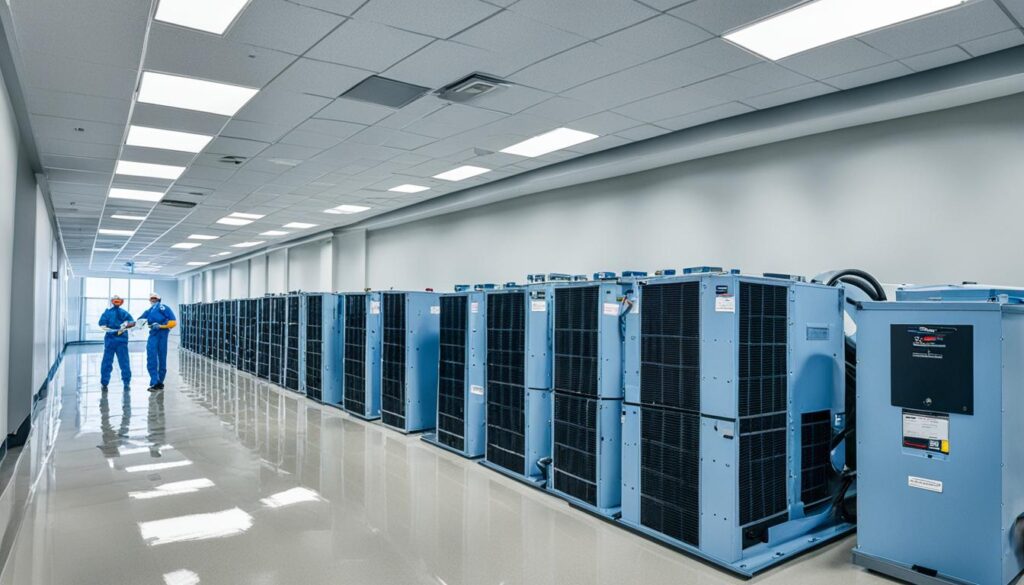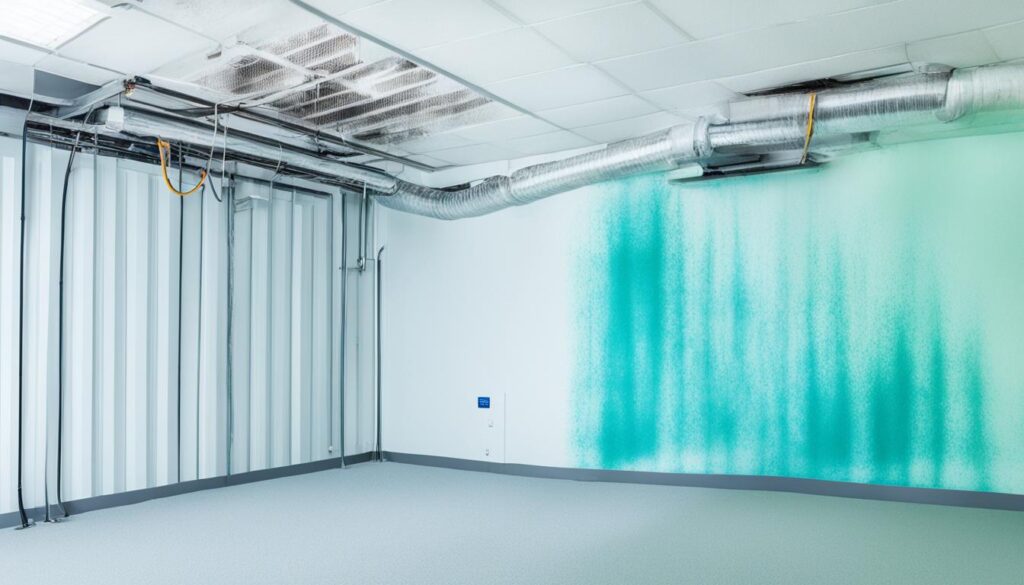
Mold Prevention for Florida Gov Buildings Guide
In this section, we will discuss essential mold prevention guidelines specifically tailored for government buildings in Florida. These guidelines are crucial for maintaining a healthy environment and ensuring compliance with Florida’s mold prevention regulations.
Key Takeaways:
- Implementing mold prevention measures is vital for government buildings in Florida.
- Compliance with Florida’s mold prevention regulations is necessary to ensure a safe and healthy environment.
- Regular inspections, moisture control, proper ventilation, and effective cleaning practices are key measures for mold prevention.
- The use of mold-resistant materials and employee training are important for preventing mold growth.
- By following these guidelines, government structures in Florida can achieve a mold-free environment.
Mold Prevention Measures for Government Facilities in Florida
When it comes to government facilities in Florida, implementing effective mold prevention measures is crucial for maintaining a safe and healthy indoor environment for occupants. In this section, we will explore various protocols and strategies for preventing mold growth in government buildings.
Regular Inspections
Regular inspections play a vital role in mold prevention for government facilities. By conducting thorough inspections, potential mold growth can be identified and addressed early on. Qualified professionals should assess areas prone to moisture accumulation, such as basements, bathrooms, and storage rooms. Any signs of water intrusion, leaks, or excessive humidity should be promptly addressed to prevent mold growth.
Moisture Control
Effective moisture control is essential in preventing mold in government buildings. This involves promptly addressing any water leaks, condensation issues, or plumbing problems. Proper waterproofing of building materials, such as roofs, walls, and foundations, should be ensured. Additionally, facilities should have efficient drainage systems to redirect water away from the building.
Proper Ventilation
Proper ventilation is key in preventing mold growth. Government buildings should have well-designed ventilation systems that provide adequate airflow to all areas, including spaces with high moisture levels. This helps to reduce humidity, control condensation, and prevent the accumulation of stagnant air, which creates favorable conditions for mold growth.
Effective Cleaning Practices
Implementing effective cleaning practices is crucial in mold prevention. Regular cleaning and maintenance should be conducted in areas where moisture is present, such as bathrooms and kitchens. Using appropriate cleaning products and techniques can help eliminate mold spores and inhibit their growth.
“By following these protocols, government buildings in Florida can minimize the risk of mold growth and maintain a safe and healthy indoor environment for occupants.”
By implementing these mold prevention measures, government facilities in Florida can significantly reduce the risk of mold growth and create a healthier environment for employees and visitors. The importance of regular inspections, moisture control, proper ventilation, and effective cleaning practices cannot be overstated.

Florida Mold Prevention Best Practices
When it comes to mold prevention in Florida government buildings, implementing best practices is crucial. By following these guidelines, government structures can ensure compliance with mold prevention regulations and create a mold-free environment. Let’s explore some of these best practices:
1. Proper Building Design and Construction
To prevent mold growth, it is essential to consider design and construction practices that minimize moisture accumulation. This includes proper sealing of windows and doors, effective insulation to prevent condensation, and strategic placement of HVAC systems to ensure adequate airflow. By addressing potential sources of moisture during the design phase, government buildings can create an environment that is less susceptible to mold growth.
2. Use of Mold-Resistant Materials
Using mold-resistant materials can significantly contribute to mold prevention in government structures. Opt for materials such as mold-resistant drywall, paints, and insulation that contain antimicrobial additives. These materials can help inhibit mold growth and minimize the risk of mold infestation in the long term.
3. Employee Training and Awareness
Proper employee training and awareness play a vital role in mold prevention. Educate employees about mold prevention practices, including the importance of reporting any signs of moisture or mold growth promptly. Encourage regular inspections and maintenance routines to address any potential issues before they escalate. By fostering a culture of awareness, government buildings can ensure early detection and timely action in preventing mold growth.
4. Regular Inspections and Maintenance
Regular inspections and preventive maintenance are essential for mold prevention. Implement a comprehensive inspection program that includes identifying and addressing potential moisture sources, such as leaks or faulty plumbing. Schedule routine maintenance to keep the building’s systems in optimal condition and promptly address any issues that may promote mold growth.
By incorporating these best practices, government structures in Florida can proactively prevent mold growth, ensure compliance with mold prevention regulations, and provide a safe and healthy indoor environment for employees and visitors.

| Best Practices | Benefits |
|---|---|
| Proper Building Design and Construction | – Minimizes moisture accumulation – Reduces the risk of mold growth |
| Use of Mold-Resistant Materials | – Inhibits mold growth – Long-term mold prevention |
| Employee Training and Awareness | – Promotes early detection – Timely action in preventing mold growth |
| Regular Inspections and Maintenance | – Identifies and addresses potential moisture sources – Promptly resolves issues to prevent mold growth |
Conclusion
In conclusion, mold prevention is of utmost importance when it comes to maintaining a healthy environment in government buildings across Florida. By adhering to the guidelines and best practices outlined in this guide, government facilities can effectively prevent mold growth, ensure compliance with state regulations, and provide a safe and comfortable environment for both employees and visitors.
Regular inspections, moisture control, proper ventilation, and effective cleaning practices are key measures that should be implemented to minimize the risk of mold in government buildings. Additionally, the use of mold-resistant materials during construction, along with proper employee training and awareness, can significantly contribute to preventing mold growth.
If you require professional mold assessment and remediation services for your government facility, we recommend contacting Fix Mold Miami at 305-465-6653. Their team of experts specializes in providing reliable and efficient mold solutions, ensuring the safety and well-being of your building’s occupants.




